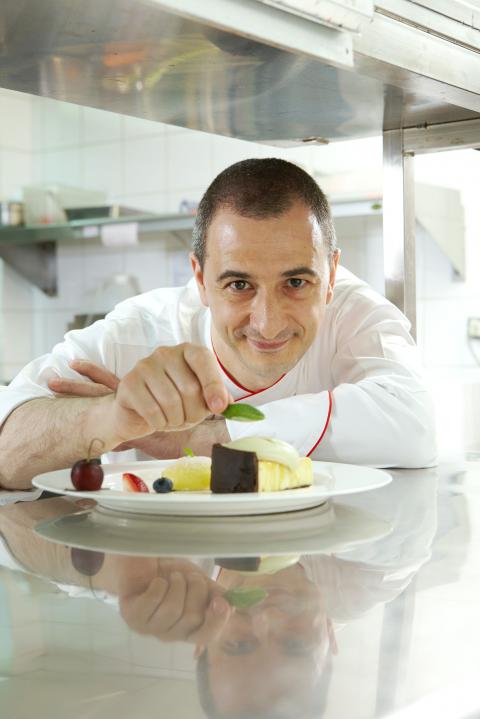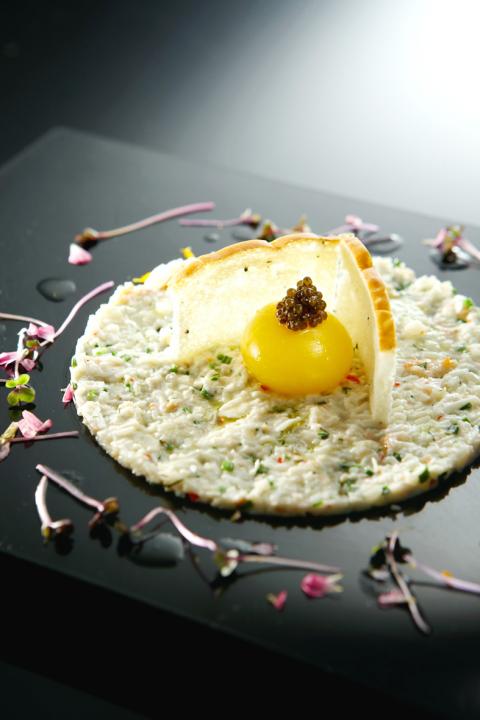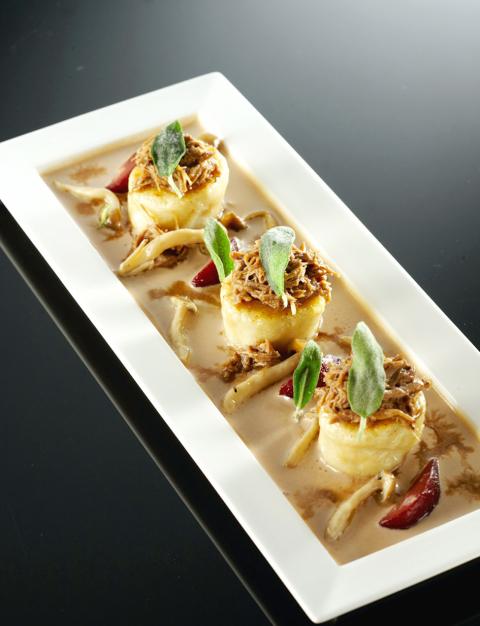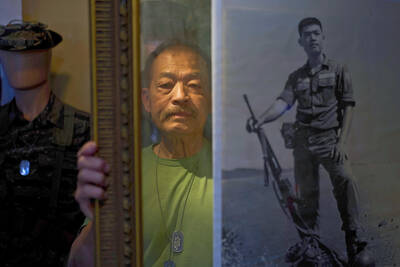The Far Eastern Hotel’s Marco Polo Restaurant has featured in the Taipei Times on many occasions, not only because it claims precedence as one of Taiwan’s best Italian restaurants, but also due to the effort it takes to invite a variety of chefs who bring their own unique style to the food.
Most recently, Chef Marco Priolo has taken the helm at Marco Polo, and has created a range of dishes intended to stamp his own personality on the restaurant under his care.
While some chefs who have taken charge of Marco Polo over the years have prided themselves on their regional affiliations — whether the cuisine of Venice, Naples or Piedmont — Priolo, who is from northern Italy, abjures any narrow regionalism, saying that this is too limiting. “After you have done the 10 or 20 signature dishes of a region, what else is left?” he asks.

Photo Courtesy of Far Eastern Plaza Hotel
Priolo, whose food is firmly rooted in Mediterranean fundamentals, has a playful culinary imagination and he draws inspiration from his travels around the world.
One of the most charming dishes to greet visitors is Priolo’s “Sunny Side-Up” Crabmeat with a hint of Chili and a Mango Yolk topped with Caviar (NT$750), which manages to set up a jokey conversation with the diner. The “white” of the sunny side-up is made up from crabmeat flavored with a complex mixture of herbs, which hint at Thailand (where Priolo was based for many years) without making the suggestion explicit. Then there is the “yolk,” which is in fact a clever little piece of molecular kitchen wizardry, a runny yellow ball of mango juice. Break this and it seeps invitingly into the crab, providing a second tier of flavor.
Another surprise can be found in the Grilled Tuna, Bok Choy and Fried Pork-Stuffed Olive Croquette served with Almond Flavored Tomato and Olive Sauce (NT$990), with its beautiful palette of fireside colors. The tuna, wearing a “grill coat” that is more often associated with beef steaks, is a delightful contrast of color and texture, and the croquette is a kind of Scotch egg with a juicy green olive at the center rather than the expected egg. Olives are often stuffed, and this one is filled with sausage meat, but then it in turn becomes the stuffing of the croquette. It’s lots of fun, though this fun goes hand-in-hand with impressive culinary skill and imagination.

Photo Courtesy of Far Eastern Plaza Hotel
Priolo was expansive about achieving an understanding of what people in different countries want from their dining experience. With a wide experience of hotel kitchens located in five-star hotels in the Middle East and Asia, he said his job was to know what people want, and achieve this through subtle tweaking of the Italian ingredients and methods that are the foundation of his cuisine.
This sometimes is achieved by departures from tradition. In the creation of Potato Gnocchi with Duck Breast Ragout served with Walnut Sauce and Red Wine Pear (NT$690), Priolo has created a scallop-sized “grand gnocchi” that is vastly huger than conventional gnocchi, but still manages to combine fluffy and chewy textures. “It is all about presenting the unexpected,” he said.
The duck ragout, which Priolo said he selected because Taiwanese favor duck, is made in Italian fashion with plenty of wine and Mediterranean herbs. For this, Priolo uses an imported bird, which he said was preferable for creating a dish very different to what Taiwanese might expect when ordering duck.

Photo Courtesy of Far Eastern Plaza Hotel
To finish off the meal, Priolo’s dessert platter (NT$420) contains a number of twists on Italian classics that are perfectly serviceable, but the sage ice cream, with its massive herbal fragrance and bitter overtones, is absolutely to die for, managing to be unexpected and exciting in the best possible way.
The new menu at Marco Polo has plenty of surprises, all delivered by well-practiced wait staff who know what the chef is about and are willing to provide guidance to the uncertain diner.

Photo Courtesy of Far Eastern Plaza Hotel

When the South Vietnamese capital of Saigon fell to the North Vietnamese forces 50 years ago this week, it prompted a mass exodus of some 2 million people — hundreds of thousands fleeing perilously on small boats across open water to escape the communist regime. Many ultimately settled in Southern California’s Orange County in an area now known as “Little Saigon,” not far from Marine Corps Base Camp Pendleton, where the first refugees were airlifted upon reaching the US. The diaspora now also has significant populations in Virginia, Texas and Washington state, as well as in countries including France and Australia.

On April 17, Chinese Nationalist Party (KMT) Chairman Eric Chu (朱立倫) launched a bold campaign to revive and revitalize the KMT base by calling for an impromptu rally at the Taipei prosecutor’s offices to protest recent arrests of KMT recall campaigners over allegations of forgery and fraud involving signatures of dead voters. The protest had no time to apply for permits and was illegal, but that played into the sense of opposition grievance at alleged weaponization of the judiciary by the Democratic Progressive Party (DPP) to “annihilate” the opposition parties. Blamed for faltering recall campaigns and faced with a KMT chair

Article 2 of the Additional Articles of the Constitution of the Republic of China (中華民國憲法增修條文) stipulates that upon a vote of no confidence in the premier, the president can dissolve the legislature within 10 days. If the legislature is dissolved, a new legislative election must be held within 60 days, and the legislators’ terms will then be reckoned from that election. Two weeks ago Taipei Mayor Chiang Wan-an (蔣萬安) of the Chinese Nationalist Party (KMT) proposed that the legislature hold a vote of no confidence in the premier and dare the president to dissolve the legislature. The legislature is currently controlled

Dull functional structures dominate Taiwan’s cityscapes. But that’s slowly changing, thanks to talented architects and patrons with deep pockets. Since the start of the 21st century, the country has gained several alluring landmark buildings, including the two described below. NUNG CHAN MONASTERY Dharma Drum Mountain (法鼓山, DDM) is one of Taiwan’s most prominent religious organizations. Under the leadership of Buddhist Master Sheng Yen (聖嚴), who died in 2009, it developed into an international Buddhist foundation active in the spiritual, cultural and educational spheres. Since 2005, DDM’s principal base has been its sprawling hillside complex in New Taipei City’s Jinshan District (金山). But